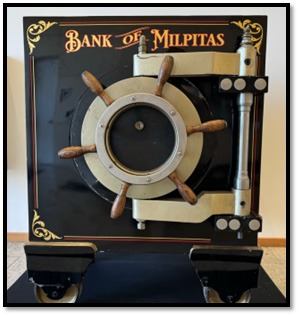Tripping Through Time Story
Milpitas Bank Safe Journeys, Safe Repairs
Safe Journeys
In early 1912, Milpitas was a thriving and busy little town, rebuilding from a devastating fire 18 months earlier, exhibiting a “can-do” spirit. One of its plucky citizens was Edward Giacomazzi, born in Pajaro, Monterey County, and the son of Swiss-immigrant farmers. The family moved to San Jose in the 1890s. In 1904, when he was 26 years old, Edward opened a dry goods store in Milpitas, became deputy postmaster, and in 1912 became the founder-president of the Bank of Milpitas.
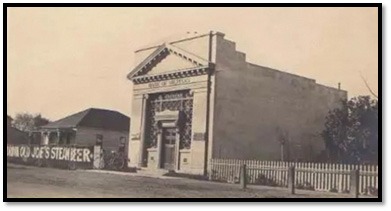
Of course, the bank needed a safe in which to store money and important records, so Giacomazzi bought a used Mosler screw-door safe made around 1890 with a Mosler Type 1 time-lock of which less than ten are known to exist todaty. These screw door safes were also known as “Banker Money Chests,” typically used in the office as an addendum to a main bank vault. The safe was used in the Bank of Milpitas until Bank of America bought the bank in 1936. Bank of America rebranded the façade of the building in 1937 and also made several inside security enhancements. By the mid-1950s, Bank of America needed a modern facility because of the opening of the new Ford Assembly Plant, so it demolished the original building and put up a new one in its place. B of A soon outgrew that new building as well and it moved around the corner into a building on Serra Way in 1970.
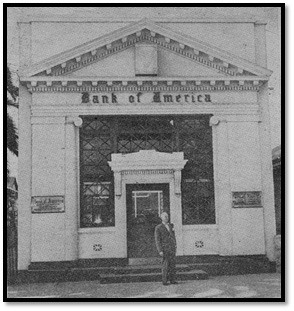
Over the years the old safe was moved around, during which the documentation does not exist, but it finally ended up in a farmhouse on the property of the San Jose-Santa Clara Water Pollution Control Plant. Around 1989, a worker noticed the Bank of Milpitas lettering on the safe and alerted the San Jose Historical Museum (which in 1998 was merged into today’s History San Jose Park). The aging safe was moved there and put into storage, out of the public eye and nearly forgotten. The safe eventually was returned to Milpitas through the efforts of Milpitas Historical Society co-founder Robert McGuire. Using a forklift borrowed from local businessman Bob Olinger, it was moved into the newly founded Bank of Milpitas (which had no connection to the original 1912 Bank) after it had been painted black to cover its very worn copper-green coloring. Some years later U. S. Bank acquired the “second” Bank of Milpitas with the 1890 safe still in its lobby. The Society recently received the old safe as a donation from U. S. Bank, and we started the project of repairing it to become a translation of its former image.
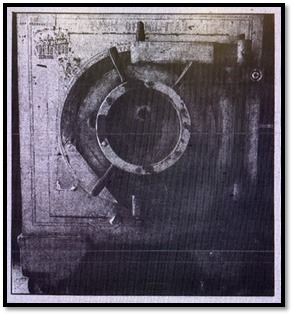
Safe Repairs
The old safe weighs about 4,000 pounds, so it requires skilled professionals with the knowledge and appropriate tools to safely handle such items. This photo shows the safe being removed from the North Milpitas Blvd. branch of U. S. Bank, which was closing that same week. These two men were in the process of transporting the old safe to the Security Safe Company in Hayward where it would undergo needed repairs before the Society could put it on public display. As it turns out, Andy Andreasen, Vice-President of that company, is a world authority on antique safes. He provided a lot of historical information to the Historical Society about our newly-acquired treasure.
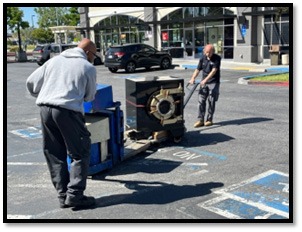
Upon inspection they found that the extremely heavy solid steel door (in the photo you can see how thick it is) was not aligned properly, preventing proper closure. This posed a serious safety risk as someone could be badly hurt while either intentionally opening the door to better see what the inside looks like or accidentally closing the door onto someone’s hand. What was causing the misalignment was not obvious on casual inspection, so a special stand was made to facilitate removal of the screw door. After dismantling, it was discovered that the main hinge pin was bent and could not be straightened. The solution was the custom machining of a replacement pin and the remounting of the door onto the safe to tesr it. The success-ful repiar of our 1890 safe is due entirely to the expert person-nel at Security Safe Company.
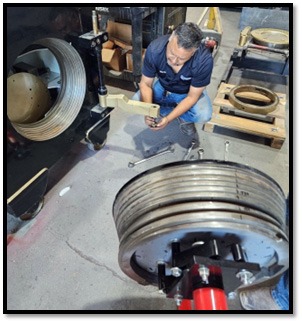
The 1912 Bank of Milpitas repairs have been completed and we have added decorative elements to provide a “finish” to its overall appearance. It probably has a better “look” now than it might have had in 1912, but this should only attract more interest and engender more respect for the historically signifi-cant artifact that it is. This beautiful, more-than-130-year-old “restored” Mosler safe can now be seen inside the northern entrance of Milpitas City Hall. As such it becomes an impor-tant display element honoring the City’s 70th anniversary of its incorporation in 1954 (transitioning from its township status since the 1850s).
